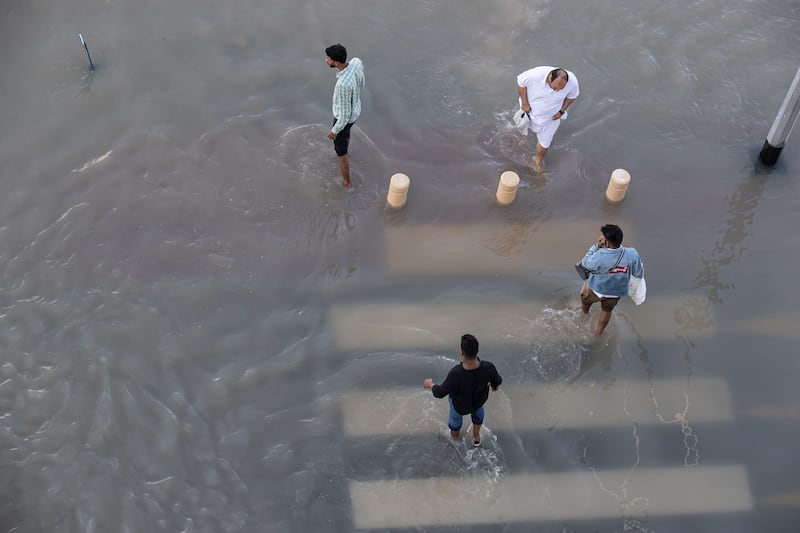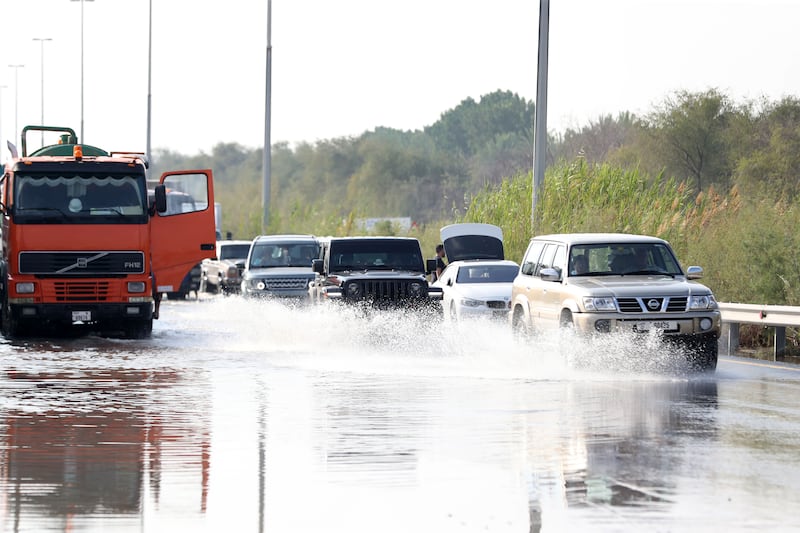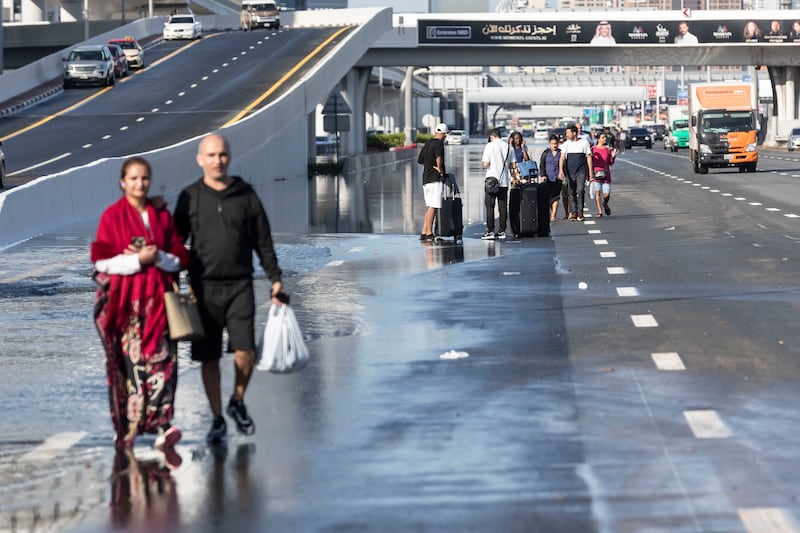Middle East and East Mediterranean heating faster than global averages, bringing more instability to weather




















Flooding in the Al Barsha area of Dubai. Chris Whiteoak / The National
Climate change brings the perils of fire and water. The Gulf might have thought extreme heat was its biggest threat, but last week demonstrated that water, too, is a threat. The region needs an integrated approach to cope with rising seas, floods and drought.
The UAE’s downpour was one of a string of record-setting extreme weather globally. It was Dubai’s heaviest for 75 years – perhaps even longer, given that records began in 1949.
Worldwide sea-surface temperatures this year are exceptionally hot – some 0.2°C higher than last year, which was itself 0.2°C hotter than the long-term average through the second half of 2023.
When we’re already hovering around the Paris Agreement’s target of no more than 1.5°C warming by 2100, 0.2-0.4°C is a lot. Long-term warming plus the El Nino effect can account for most of this, but there is still an anomaly that is not fully explained.
The Middle East and East Mediterranean are heating up even faster than the global average – by about 0.45°C per decade. For the UAE specifically, this will bring more rain, from 15-35 per cent higher by the end of the century.
On its own, that is not so dramatic and should be welcome. But when rains come in our hotter world, they are stronger.
Every degree of warming means the atmosphere can hold about 7 per cent more moisture. The increase in extreme rainfall is more – perhaps twice as much.
Four people were reported dead in the UAE and 19 in Oman as a result of the floods.
Tragic as this is, things are much worse in other regional states: at least 11,300 died in the Libyan city of Derna in September when two dams collapsed following Storm Daniel.
This was a rare Mediterranean cyclone, which is forecast to become more common with climate change. Huge floods in Pakistan in August 2022 inundated much of the country and killed more than 1,300 people.
Climate threat
The second watery threat to the region originates elsewhere: higher sea levels from melting ice and the expansion of the oceans as they warm.
In the wider region, sea levels are projected to rise up to 90 centimetres by 2100. This could be intensified during storm-induced flooding.
This would directly affect low-lying coastal areas of Abu Dhabi, Umm Al Quwain, western Qatar, Khobar and Jubail in eastern Saudi Arabia, south-western Iran and south of Misurata in Libya.
The more dramatic impact comes in the deltas of the Nile, Shatt al Arab, Indus and Ganges-Brahmaputra – Egypt, Iraq, Iran, Pakistan, India and Bangladesh – where broad swathes of land would be inundated without defence measures.
Flooding could reach as far inland as Nasiriyah and Amarah in Iraq, some 200 kilometres from the Gulf coast.
These areas contain millions of people, rich agricultural land, sensitive ecosystems such as the Iraqi marshes, major cities, ports and energy infrastructure – oilfields, petrochemical plants and refineries and oil and gas export terminals.
The third great threat is the converse of the first: drought.
Climate change brings the perils of fire and water. The Gulf might have thought extreme heat was its biggest threat, but last week demonstrated that water, too, is a threat. The region needs an integrated approach to cope with rising seas, floods and drought.
The UAE’s downpour was one of a string of record-setting extreme weather globally. It was Dubai’s heaviest for 75 years – perhaps even longer, given that records began in 1949.
Worldwide sea-surface temperatures this year are exceptionally hot – some 0.2°C higher than last year, which was itself 0.2°C hotter than the long-term average through the second half of 2023.
When we’re already hovering around the Paris Agreement’s target of no more than 1.5°C warming by 2100, 0.2-0.4°C is a lot. Long-term warming plus the El Nino effect can account for most of this, but there is still an anomaly that is not fully explained.
UAE records heaviest rainfall in 75 years

The Middle East and East Mediterranean are heating up even faster than the global average – by about 0.45°C per decade. For the UAE specifically, this will bring more rain, from 15-35 per cent higher by the end of the century.
On its own, that is not so dramatic and should be welcome. But when rains come in our hotter world, they are stronger.
Every degree of warming means the atmosphere can hold about 7 per cent more moisture. The increase in extreme rainfall is more – perhaps twice as much.
Four people were reported dead in the UAE and 19 in Oman as a result of the floods.
Tragic as this is, things are much worse in other regional states: at least 11,300 died in the Libyan city of Derna in September when two dams collapsed following Storm Daniel.
This was a rare Mediterranean cyclone, which is forecast to become more common with climate change. Huge floods in Pakistan in August 2022 inundated much of the country and killed more than 1,300 people.
Climate threat
The second watery threat to the region originates elsewhere: higher sea levels from melting ice and the expansion of the oceans as they warm.
In the wider region, sea levels are projected to rise up to 90 centimetres by 2100. This could be intensified during storm-induced flooding.
This would directly affect low-lying coastal areas of Abu Dhabi, Umm Al Quwain, western Qatar, Khobar and Jubail in eastern Saudi Arabia, south-western Iran and south of Misurata in Libya.
https://ourworldindata.org/grapher/sea-level
The more dramatic impact comes in the deltas of the Nile, Shatt al Arab, Indus and Ganges-Brahmaputra – Egypt, Iraq, Iran, Pakistan, India and Bangladesh – where broad swathes of land would be inundated without defence measures.
Flooding could reach as far inland as Nasiriyah and Amarah in Iraq, some 200 kilometres from the Gulf coast.
These areas contain millions of people, rich agricultural land, sensitive ecosystems such as the Iraqi marshes, major cities, ports and energy infrastructure – oilfields, petrochemical plants and refineries and oil and gas export terminals.
The third great threat is the converse of the first: drought.
While global warming will raise the amount of precipitation in the south-eastern Arabian Peninsula – from very low levels – it will lead to drier conditions across the northern tier of the Middle East from the Levant to Iraq and Iran.
Already droughts have reduced hydroelectric output in Turkey and Iran, leading to lost crops, local protests and more use of coal, oil and gas. Drought in Syria has shaped and worsened its civil war in complex ways. Dust storms blanket the region and worsen respiratory illnesses.
The South Asian monsoon, on which hundreds of millions depend for water and sustenance, is likely to become wetter but also more variable and extreme.
Local air pollution, though, for instance from burning coal, weakens the monsoon. Melting glaciers also mean more flooding, but eventually less reliable river flows.
Shared challenges
The wealthy UAE and its GCC neighbours can cope with the direct impacts of such events. Improved drainage, more green spaces, storm warnings, dams on wadis, emergency procedures and full home insurance would limit the effect of heavy rains.
Sharjah, for example, has built Al Hefaiyah Lake on the Sharjah-Kalba Road to capture flash floods from the mountains, while Dubai has opened a flood management centre to keep roads clear. The troubles at Dubai Airport revealed how blockages in transport around the city cascade into breakdowns elsewhere.
Coastal defences, restoration of mangroves and careful planning of critical infrastructure near sea level can protect against rising sea levels.
And as the GCC is already very arid, it is already prepared for droughts, with desalination, atmospheric moisture collection, sewage recycling, water storage above and below ground, and, in the UAE, cloud-seeding to draw rainfall from less pendulous clouds.
But the region would greatly benefit from wider co-operation on these shared challenges.
Large regional neighbours may lack the expertise and capital to adapt. Food shortages, economic struggles, migration, political instability and violence there could seriously affect the GCC too. The Middle East’s numerous, multisided, complex political tensions and conflicts make co-operation difficult, yet more essential.
Egypt confronts Ethiopia over the Nile, Pakistan and India dispute the headwaters of the Indus, Turkey and Iran leverage their control of the Tigris and Euphrates tributaries against Iraq. But these major cross-boundary river systems also have the potential to spur co-operation, perhaps with the help of outside mediation.
Developing region-wide, fine-scale climate models would help to understand the likely changes in precipitation over the rest of the century, including the potential benefits of cloud-seeding.
The GCC can bring its expertise in water recycling and desalination to neighbours. Dryland agriculture techniques, and crop varieties that are tolerant of drought and salinity, help to preserve rural economies and improve food security. Integrated planning and investment in strategic multinational water reserves and coastal defences help build regional trust.
Last week’s Dubai deluge was a timely warning. The UAE can fix its own problems, but the region needs to work together to cope with a future of too much and too little water.
Robin M. Mills is chief executive of Qamar Energy, and author of The Myth of the Oil Crisis
https://www.thenationalnews.com/business/energy/2024/04/22/uae-rain-climate-change/
